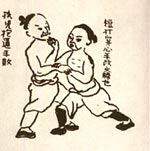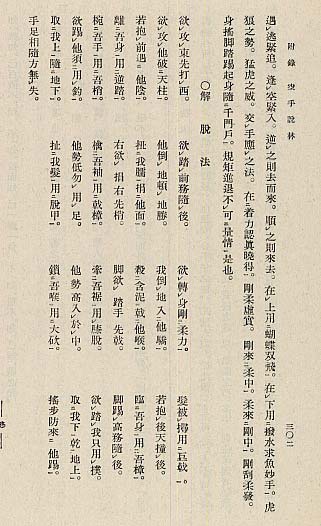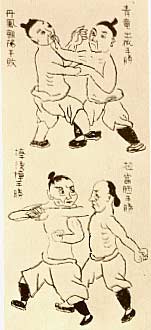Enter The bubishi
Part 1- Introduction & Origins
By Victor Smith
Editor's Note:
This is the first in a three part series on the bubishi.
Part 2will discuss the text and its impact on Okinawan
karate. Part 3 will discuss the availability of translations
of the text in English, the text's impact on karate
today and the current status of research on this text.
 It
is an obscure martial arts text written in Chinese.
But, it was a most cherished possession of many of
the great founders of modern karate -- something that
was meticulously hand copied and shared among only
their most trusted students. It
is an obscure martial arts text written in Chinese.
But, it was a most cherished possession of many of
the great founders of modern karate -- something that
was meticulously hand copied and shared among only
their most trusted students.
It is called the bubishi.
The bubishi's age and the origin are unknown. Yet,
while the text remains a mystery, it is also the only
historical written record of martial techniques and
theory to have emerged from karate's shrouded past.
Karate, as we know it, became known to the world
in the early 20th century after emerging in Okinawa
after centuries of secret practice. It was taught
publicly for the first time around 1905. Its origins
too remain obscure, tangled in a conflicting web of
myth and oral tradition -- a mixture of native art
(te, meaning hand) mixed with Chinese and other fighting
traditions.
In the 1930's the first public reference was made
to the existence bubishi in the hands of senior Okinawan
karate instructors. By this time karate had been introduced
into Japan, and Okinawan martial artists had begun
publishing books in Japanese to publicize and gain
approval for their imported art.
In their writings, both Ginchin Funakoshi (founder
of Shotokan karate) and Kenwa Mabuni (founder of Shito-ryu
karate) made public what had previously been a closely
held secret in the Okinawan arts. It is also said
that the founder of Goju-ryu karate, Chojun Miayagi,
named his style after a phrase taken from this book.
(1)
In 1922 Funakoshi published the first book on karate
in Japan, "Ryukyu Kenpo Toudi." Four chapters
from the bubishi were included at the end of the book,
but the bubishi itself was not named. The bubishi
section was also not translated. It was left in its
original Chinese style of writing. (2)

In 1934 when Kenwa Mabuni published "Seipai
No Kenkyu" (Study of Seipai) the bubishi was
named. Mabuni included the drawings from five chapters
from Anko Itosu's copy of the bubishi (Itosu had been
Mabuni's teacher and is considered the founder of
shorin-ryu karate. Itosu first taught karate in public
on Okinawa). Interestingly Mabuni dedicated more pages
of his book to the bubishi (95, in fact) than he used
for the purported subject of the book (79 pages),
the kata Seipai.
 Another
later text, "Karate, Goju-ryu by the Cat,"
by Gogen Yamaguchi (founder of Japanese Goju karate),
also discussed text. The book included 39 pages from
the bubishi (mostly illustrations as shown here) as
a separate chapter, but no translation of any of the
text was provided. (3) Another
later text, "Karate, Goju-ryu by the Cat,"
by Gogen Yamaguchi (founder of Japanese Goju karate),
also discussed text. The book included 39 pages from
the bubishi (mostly illustrations as shown here) as
a separate chapter, but no translation of any of the
text was provided. (3)
Now available in several English language renditions
the bubishi, allows us to enter the world of mystery
and possibility that so endeared the text to the founders
of modern karate who we revere today.
The Origins
There is no definitive answer to where the bubishi
originated, or even who wrote it. In the same light,
we cannot even be sure who possessed copies for their
own use.
Prior to the 20th century, Okinawan martial artists
did not document their arts. Karate was practiced
in secret and many teachers were not literate. As
a result, what is known of karate and its origin is
the product of a relatively recent oral tradition.
Thus, it becomes very difficult to prove any source
or trace exact history.
In contrast, in China, where martial arts practice
had been done in the open, books about self-defense,
kung fu systems, exercises and forms (kata) were as
common in the end of the 19th century as today. They
were also used as a learning tool by many people to
learn about empty hand self-defense. (4)
We don't know, however, if the bubishi was written
or compiled in Southern China or on Okinawa. We do
know it was written in Chinese. It could be a personal
notebook of someone trained in White Crane and Monk
Fist (Shaolin) kung fu arts. Equally it could be a
compilation of martial arts notes from many sources.
We also know that Miyagi Chojun (the originator of
Goju Ryu) had a copy most likely copied from his teacher,
Higashionna Kanryo. (5)
Patrick McCarthy, the well known martial arts historian
and writer, also notes that Mabuni Kenwa was allowed
to copy the bubishi from the version owned by his
instructor, Master Itosu. McCarthy also writes "I
understand there are others," meaning copies
in other hands. (6)
All of these copies of the bubishi are not identical.
They contain different chapters and the drawings of
the self-defense techniques vary somewhat in the strike
being used and the target attacked.
In sum, the bubishi is one part of the eclectic synthesis
of karate as it developed on Okinawa in 19th and 20th
centuries. Having only an oral tradition teachers
exchanged knowledge and learned from each other, or
visited China to study various Chinese Kung Fu styles.
Others, like Funakoshi, sought to preserve the island's
fighting heritage by recording and learning many ancient
kata.
Thus, the existence of a written fighting arts text
(bubishi) was unique and considered important even
if the text was not fully understood. As a result,
many karate masters meticulously hand copied the bubishi
and later published excerpts from it.
What is not known is how much of the bubishi was
understood by early 20th century karate teachers,
or how much of its knowledge was adopted into the
systems they pioneered.
Footnotes:
(1)
Joe Swift noted to this author that Miyagi had named
Gojuryu from the Bubishi has been published in old
Japanese karate books as well, and he had a 1942 article
named after that precept (Miyagi that is).
(2) It is therefore questionable
how many could actually read or understand what was
reproduced. The Funakoshi editions, it should be noted,
only reproduced written text and not diagrams or drawings.
In later reprinted English editions of Funakoshi's
1926 book, "Tote Jitsu," by Masters Publications,
1964, the translator noted that "I was unable
to translate the Chinese style" and although
several people were consulted, they "were also
unable to help." The same segment from the bubishi
was later published in the English version of "Karate-Do-
Kyohan" published in 1973. The translator noted
that he was unable to locate the original source of
the material reproduced that was written in the Chinese
style.
(3) The chapter titled, "Introduction
of Part of bubishi," in Yamaguchi's book contained
mostly (35 of the 38 pages) illustrations of self-defense
moves and/or diagrams of the body's vulnerable points
from the bubishi. The English translation of the book
had no translations of the written text.
(4) Fernando Camara, from
a lecture recorded at his website: http://www.geocities.com/Colosseum/Bleachers/6758/hakutsuru_menu.htm
(5) The Higashionna bubishi
is mentioned by John Sells in his historical volume,
"Unante-The Secrets of Karate." Higashionna
may have been illiterate, and thus his version of
the bubishi is a topic of some controversy. Was it
his own journal, or given to him, possibly in Fujian,
a province in China where he studied?
(6) Ancient Okinawan Martial Arts, Volume Two
- Koryu Uchinadi.
About The Author:
Victor Smith is a respected teacher of Isshinryu
karate (6th degree black belt) and tai chi chuan
with over 26 years of training in Japanese, Korean
and Chinese martial arts. His training also includes
aikido, kobudo, tae kwon do, tang so do moo duk
kwan, goju ryu, uechi ryu, sutrisno shotokan, tjimande,
goshin jutsu, shorin ryu honda katsu, sil lum (northern
Shaolin), tai tong long (northern mantis), pai lum
(white dragon), and ying jow pai (eagle claw). Over
the last few years he has begun writing on, researching
and documenting his studies and experiences. He
is the founder of the martial arts website FunkyDragon.com/bushi
and is Associate Editor of FightingArts.com. Professionally
he is a business analyst, but also enjoys writing
ficton for the Destroyer Universe.

back
to top
home
| about
us | magazine
| learning
| connections
| estore
|